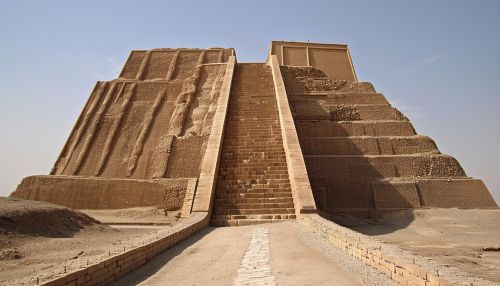History of Mesopotamia
Introduction
Mesopotamia, often referred to as the "Cradle of Civilization," is a historical region situated within the Tigris-Euphrates river system, corresponding to modern-day Iraq, Kuwait, and parts of Syria, Turkey, and Iran. This article delves into the comprehensive history of Mesopotamia, exploring its ancient civilizations, cultural developments, and significant contributions to human history.
Geography and Early Settlements
Mesopotamia's geography played a crucial role in its development. The region is characterized by the fertile plains between the Tigris and Euphrates rivers, which provided abundant water and fertile soil for agriculture. Early settlements in Mesopotamia date back to the Neolithic period, around 10,000 BCE, with evidence of small farming communities.
Sumerian Civilization
The Sumerians are credited with establishing one of the earliest civilizations in Mesopotamia around 4500 BCE. They developed city-states such as Ur, Uruk, and Eridu, each with its own ruler and deity. The Sumerians are known for their innovations in writing, architecture, and governance.
Writing and Literature
The Sumerians invented cuneiform, one of the earliest forms of writing, around 3400 BCE. Cuneiform was initially used for record-keeping and later evolved to include literature, legal codes, and administrative documents. The Epic of Gilgamesh, one of the oldest known literary works, originates from this period.
Architecture and Urban Planning
Sumerian architecture is notable for its ziggurats, large terraced structures that served as temples. The city of Uruk, one of the world's first major cities, featured advanced urban planning with distinct residential, commercial, and religious districts.
Governance and Society
Sumerian city-states were governed by a combination of theocratic and monarchic systems. The Code of Ur-Nammu, one of the oldest known legal codes, highlights the Sumerians' sophisticated legal and administrative systems.


Akkadian Empire
The Akkadian Empire, established by Sargon of Akkad around 2334 BCE, is considered the world's first empire. It unified various Sumerian city-states under a central authority and expanded its territory through military conquests.
Sargon of Akkad
Sargon, the founder of the Akkadian Empire, is a legendary figure in Mesopotamian history. His reign marked significant advancements in administration, trade, and military organization. The empire's capital, Akkad, became a major cultural and economic center.
Cultural and Technological Contributions
The Akkadians adopted and adapted Sumerian culture, including cuneiform writing. They also made advancements in metallurgy, weaponry, and art. The Stele of Naram-Sin, depicting Sargon's grandson, is a notable example of Akkadian art.
Babylonian Empire
The Babylonian Empire rose to prominence under the rule of Hammurabi around 1792 BCE. Babylon became the cultural and political center of Mesopotamia, known for its impressive architecture and legal innovations.
Hammurabi's Code
Hammurabi is best known for his legal code, the Code of Hammurabi, one of the most comprehensive and well-preserved ancient legal documents. It established laws and punishments, emphasizing justice and social order.
Babylonian Achievements
Babylonian achievements include advancements in astronomy, mathematics, and literature. The Enuma Elish, a Babylonian creation myth, and the Epic of Gilgamesh were significant literary works of this period.
Assyrian Empire
The Assyrian Empire, known for its military prowess and administrative efficiency, dominated Mesopotamia from the 14th to the 7th century BCE. The Assyrians expanded their territory through conquest and established a centralized bureaucracy.
Military Innovations
The Assyrians are renowned for their military innovations, including the use of iron weapons, cavalry, and siege warfare techniques. Their armies were highly disciplined and well-organized, contributing to their success in expanding the empire.
Administrative and Cultural Developments
The Assyrians developed an efficient administrative system, with provincial governors overseeing various regions. They also made significant contributions to art and architecture, as seen in the Palace of Sargon II and the Library of Ashurbanipal.
Neo-Babylonian Empire
The Neo-Babylonian Empire, also known as the Chaldean Empire, emerged in the 7th century BCE. It is best known for its cultural renaissance and monumental architecture under the rule of Nebuchadnezzar II.
Nebuchadnezzar II
Nebuchadnezzar II, one of the most famous Babylonian kings, is credited with the construction of the Hanging Gardens of Babylon, one of the Seven Wonders of the Ancient World. His reign marked a period of prosperity and cultural revival.
Cultural and Scientific Achievements
The Neo-Babylonians made significant advancements in astronomy, mathematics, and literature. They developed a sophisticated calendar system and made important contributions to the field of astronomy.
Persian Conquest and Later Periods
The Achaemenid Empire, led by Cyrus the Great, conquered Mesopotamia in 539 BCE. This marked the end of Mesopotamian independence and the beginning of Persian rule. Despite the conquest, Mesopotamian culture and knowledge continued to influence the region.
Hellenistic Period
Following the conquest of the Achaemenid Empire by Alexander the Great in 331 BCE, Mesopotamia became part of the Hellenistic world. The Seleucid Empire, one of Alexander's successor states, ruled the region, blending Greek and Mesopotamian cultures.
Parthian and Sassanian Periods
The Parthian and Sassanian Empires controlled Mesopotamia from the 3rd century BCE to the 7th century CE. These periods saw continued cultural and scientific developments, as well as the spread of religions such as Zoroastrianism and Christianity.
Legacy of Mesopotamia
Mesopotamia's legacy is profound, influencing subsequent civilizations in various fields such as writing, law, architecture, and science. The region's contributions to human history are evident in the enduring impact of its innovations and cultural achievements.
